
Books

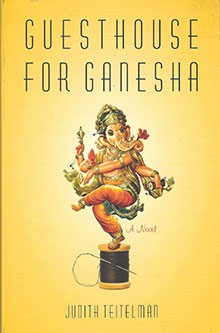 “Guesthouse for Ganesha” (352 pages; $17.95) by Judith Teitelman; published by She Writes Press (www.shewritespress.com)
“Guesthouse for Ganesha” (352 pages; $17.95) by Judith Teitelman; published by She Writes Press (www.shewritespress.com)
Since we celebrate Ganesh Chaturthi this month (Aug. 22), we thought it would be appropriate to review this vividly written part magical realism/fictional account by Teitelman. It follows the story of young Esther Grunspan as she “arrives in Koln (Cologne) with a heartened heart as her sole luggage.” It is 1923 and rumblings of a dictator are beginning. The Jewish master tailor is not alone on her 22-year journey, which will then take her to Wupperthal (Germany), Paris, Switzerland and finally India. Her trusted traveling companion, Lord Ganesha, is the book’s narrator who addresses her abandonment at the marriage chuppah by a man she had trusted and loved. But it is just the beginning of a path that will result in a loveless marriage and losing two of her three children to Kindertransport (organized rescue mission for Jewish children). With a baby in tow and a new name and identity to escape the Nazi turncoats, the resolute and fiercely driven woman treks on with Ganesha and his abilities to destroy obstacles leading the way: “I choose Esther because she is a woman … a soul … who experienced … who truly and deeply … to the core of her being understood … understands … love. Pure love. The truth of love and its power and its strength … and its purpose.” And when the silhouette of the manifest God takes form, she is aghast but appreciative: “This elephant-headed man was draped in layers of luscious yellow and red diaphanous silk clothes. Countless claims of exquisite mala – each with 108 flawless beads – reserved against His throat, garlands of red hibiscus flowers lay upon His chest. His four arms and hands seemed in constant motion yet without movement.” Ms. Teitelman, please take a bow for an inspiring and touching story of love, loss and spirit beautifully told with great conviction and style. The debut novel, which weaves Eastern beliefs with stark realities, speaks volumes about the talent of this budding author.
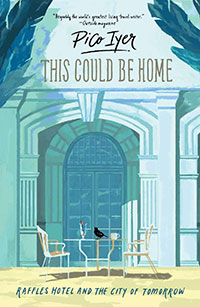
“This Could Be Home: Raffles Hotel and the City of Tomorrow” (114 pages; $12) by Pico Iyer; published by Epigram Books (www.epigrambooks.sg)
“Often, I suspect, people come to Singapore to visit Raffles as much as they come to Raffles to enjoy Singapore,” notes our favorite travel author during one of his visits in 35 years. His books about crossing cultures such as “Video Night in Kathmandu,” “The Lady and the Monk” and especially “The Global Soul” are treasures to be cherished forever. Though “This Could Be Home” is more of a puff piece on the city-state and the hotel, the book still has the distinct Pico Iyer appeal to it. Built in 1887, the iconic Raffles Hotel (whose namesake Sir Thomas Stamford Bingley Raffles visited Singapore for hardly a month, according to historians) has undergone just two renovations in its history, the most recent one just last year. It began as a 10-room hotel before expanding to the present 115 and offering nine suite types. More than 600 workers labored for over a year on the historic monument with its “cast-iron verandah and balustrades and cornices.” Iyer sets the mood and tone for the reader as he steps in to check the backdrop: “In one corner Elizabeth Taylor, in a large, framed black-and-white photo, appears to be helping herself to a piece of history; in another, Somerset Maugham is taking silent measure of the storied bar in its latest incarnation.” And stories that have unfolded before the author are plenty, such as a loyal guest from Germany who visits four times a year for a month each time, or the couple from Switzerland who stays at Raffles for six months every year, “the two of them dine at the same table every evening and toast one another with Champagne every night.” To them, “it’s their old friend’s place in the country where they can drop in whenever the time is right, as familiar as home and as comforting,” notes the author. The motto of Raffles Institution is: AUSPICIUM MELIORIS AEVI, which translates to hope of a better age. Though the language in which the saying was written is dead, Iyer says, “But the hope – more and more people are streaming into the new hotel around me, old and young, dark and blond, hip and highly retro – is very much alive. Home, quite beautifully, can be a creation of the future as much as of the past.” Though critics have slammed “This Could Be Home” as a blatant ad/brochure for Raffles and Singapore (Iyer is the first Writer-in-Residence for the Raffles Writer’s Residency program), we will take Pico Iyer over any other travel writer any time.
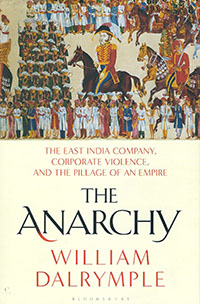 “The Anarchy: The East India Company, Corporate Violence, and the Pillage of an Empire” (528 pages; $35) by William Dalrymple; published by Bloomsbury Publishing (www.bloomsbury.com)
“The Anarchy: The East India Company, Corporate Violence, and the Pillage of an Empire” (528 pages; $35) by William Dalrymple; published by Bloomsbury Publishing (www.bloomsbury.com)
The next time you hear talk about the British conquering India and ruling the country for nearly 200 years, think again. Better yet, grab a copy of “The Anarchy” by one of our favorite narrative historians (“The Last Mughal” and “Return of a King”). Dalrymple lays out in minute and intricate details how a dangerously unregulated private for-profit company headquartered in a small office, five windows wide, in London, colonized a nation thousands of miles away. Founded in 1600, the East India Company was comprised of pirates, adventurers, merchants and ambitious London officials. Leading the charge was its accountant, Robert Clive, who through his ruthlessness and military acumen ascended to become Governor of Bengal. In 1765, he led the charge to defeat and send into exile Mughal emperor Shah Alam from Delhi to be replaced by ‘the high and mighty, the noblest of exalted nobles, the chief of illustrious warriors, our faithful servants and sincere well-wishers, worthy of our royal favours, the English Company.” It was this new admin of traders who began collecting taxes – what would today be called an act of involuntary privatization. In less than 40 years, the private security force had swelled to about 200,000 men who, after the takeover of Bengal, marched on to the Mughal capital and almost all of India south of that city. “It had also, by this stage, created a sophisticated administration and civil service, built much of London’s docklands and come close to generating half of Britain’s trade,” notes Dalrymple. The story of the East India Company is as relevant even today, 425 years after its founding, cautions the author. “The most powerful among them do not need their own armies: they can rely on governments to protect their interests and bail them out,” notably the international subprime bubble and bank collapses of 2007-09. Indeed, history can repeat itself!
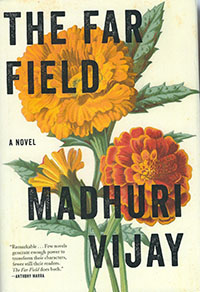 “The Far Field” (440 pages; $27) by Madhuri Vijay; published by Grove Atlantic (www.groveatlantic.com)
“The Far Field” (440 pages; $27) by Madhuri Vijay; published by Grove Atlantic (www.groveatlantic.com)
For a debut book, this is a triumphant one, drawn by the author from the experience of living and working in locales where the story backdrop takes place. After all, there aren’t many novels that start in the “Garden City” and end up in “Paradise.” It all begins in Bangalore for a 20-something Shalini who lives with her widowed father. After the death of her mother, the fortunate and gullible young woman decides to go to Kashmir to find Bashir Ahmed, a traveling salesman who visited her childhood home and was close to her disturbed mother. It was a relationship that rankled and fascinated the daughter, a sort of puzzle that she felt had to be unveiled. “Kishtwar. It was a town that lay on the Jammu side, six thousand feet above sea level,” discovers Shalini. “A town most famous for its shrines, especially those of two legendary Sufi saints.” And then she recalled Ahmed’s words, “My wife’s whole family is from there.” That clue was more than enough for the naïve and edgy Bangalorean to head for Kashmir. “They (Indian soldiers) were everywhere, dressed in khaki or olive, congregating in tight groups on street corners or in tea stalls. Whenever I walked, a convoy of army jeeps would usually roll by, soldiers sitting in the back like bored tourists being ferried around yet another foreign city, but they mostly ignored the local people, who ignored them in turn.” It doesn’t take long before Shalini gets entangled in the political landmine and class prejudice while inching closer to the whereabouts of Ahmed. Six months ago, since India revoked Jammu and Kashmir’s autonomous status to become a Union territory, the troubled state has been in the news. As it turns out, the setting for Vijay’s book is a timely one, both politically and emotionally for the reader. Here’s hoping that the gifted author will pen more such effortlessly written and engrossing tales.
 “The Object of your Affections” (372 pages; $16.99) by Falguni Kothari; published by Graydon House (www.graydonhousebooks.com)
“The Object of your Affections” (372 pages; $16.99) by Falguni Kothari; published by Graydon House (www.graydonhousebooks.com)
It’s a simple story about relationships, friendship, motherhood, love and surrogacy told well by Kothari. New York City assistant district attorney Paris Kahn Fraser is married to a handsome, wealthy globally coveted jewelry designer Neal Singh Fraser (fourth in line to a Scottish baronage!). The problem? Paris, who herself has been adopted twice, doesn’t want to give birth to a child but Neal does crave for one of his own. Here enters a potential surrogate, an old former friend Naira Dalmia (barely 30 years of age), who has recently moved to New York from India after the death of her husband. And there are several legal and financial issues to be tackled (“Men tended to complicate the simplest of decisions with their arrogance and chauvinism – my husband included,” Naira believed). Amid twists and turns that move the story ahead at a quick pace, Paris pops the question to Naira if she would accept surrogacy. Of course, the benefit for Naira would come in the form of a huge business opportunity. Told in dual narration by Paris and Naira, “The Object of Your Affections” is a commendable attempt at exploring the hardships and struggles that can arise between friends. Though predictable in the end (“Oh, but it was good to be home”) and at times slightly more graphic than is necessary, Kothari deserves kudos for tackling the complicated subject of surrogacy with relative ease and determination.
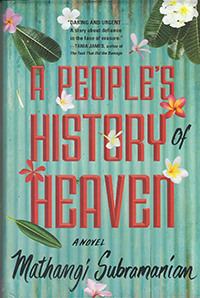 “A People’s History of Heaven” (296 pages; $26.95) by Mathangi Subramanian; published by Algonquin Books of Chapel Hill (www.algonquin.com)
“A People’s History of Heaven” (296 pages; $26.95) by Mathangi Subramanian; published by Algonquin Books of Chapel Hill (www.algonquin.com)
Deepa, Padma, Banu, Joy and Rukshana live in heaven. But their home is not a paradise. In this instance, Heaven “settled back into the lazy lights of blinking fireflies and three-wheeler headlights, the sleepy sounds of pressure cookers hissing and pots banging” is a derelict slum hidden between high-end buildings in Bangalore. That the five girls (blind, artist, dancer, born as a male) come from different religions or sexual orientations isn’t important. What is of essence is that they can take a firm stand, notably when the local government threatens to demolish their huts to make room for a shopping mail. It is then that their fierce determination to stand the ground against heavy bulldozers sent to raze homes, survive and fight against all odds comes to the forefront. This brilliantly written lyrical, elegant and debut novel by Subramanian, with a gripping plot revolving the five girls, is hard to put down once you pick it up. Here are a few subtle but candid sentences that are sheer poetry: “Ragged jigsaw of tilted tents, angry quilt of rusted roofs, maze of sagging sofas. Muddy monsoon squelch, dry summer hum and clatter of gunshot tongues firing words faster than Rajni fires bullets.” “It was a boy. Eyelids wrinkled and transparent as jasmine petals. Purple lips pinched together like carnations.” “Joy is the girl you can’t miss. Eyes large as a calf’s, long-lashed and velvet. Hips like palm fronds that billow and sway. Hair black and glittery, like a strip torn off of midnight’s double-color sky.” “You don’t have to light a match to burn a family’s life to the ground.” “It’s where the hijras (eunuchs) work. Square jaws, Adam’s apples, swinging hips. Hair like crows’ wings, eyes like temple stones.”
COOKBOOK REVIEW
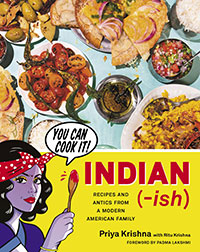 “Indian(-ish): Recipes and Antics from a Modern American family” by Priya Krishna with Ritu Krishna; 246 pages; $28; published by Houghton Mifflin Harcourt; (www.hmhbooks.com)
“Indian(-ish): Recipes and Antics from a Modern American family” by Priya Krishna with Ritu Krishna; 246 pages; $28; published by Houghton Mifflin Harcourt; (www.hmhbooks.com)
Indian(-ish)? What’s that, you may ask. Well, according to the author Priya Krishna, her mother Ritu, cooks meals reminiscent of her Indian heritage but infused with American ingredients. And those easy-to-prepare, accessible and quite delicious recipes make up for “Indian-ish” cuisine, which is also the title of the book collaborated by the mother-daughter. You are promised that preparing these cool recipes, employing Instant Pots and microwaves, isn’t a lengthy and complex process. The author, a food writer, makes it all fascinating with some witty anecdotes and portraits of the Krishna family. “It’s (book) the result of my mom writing one hundred (!!!!) recipes after stressful workdays; my dad doing hundreds of dishes wearing nothing but a lungi (Google it) …” Culinary wizardry by Ritu included making pizzas out of roti, cooking saag paneer with feta cubes instead of paneer, and turning leftover sabzi into portable, travel-size Indian taquitos, writes Priya. Complementing the recipes are striking illustrations by Maria Qamar and outstanding photography by Mackenzie Kelley. “Indian (-ish)” recipes such as Tomato-Cheese Masala Toast, Indian Ribollita, Quinoa Shrimp Pulao, Roti Pizza, Whole Roasted Cauliflower with Green Walnut Chutney will stir up not just your appetite but also your curiosity. Just so all bases are covered, the author has put together a comprehensive spice guide, a flow chart, Ritu’s guide for pairing wine with Indian food, and some fine tips for hosting and living graciously (“Appetizers are overrated, and distract from all the hard work you put into a meal.”) There is even a chapter on “Why My Yogurt is Fabulous” by dad Shailendra! So, if you would like to try out one or more of the “Indian(-ish) recipes, this cookbook will satisfy your palate!
Here is a recipe reproduced with permission:
-Mackenzie-Kelley.jpg) Chickpea Flour Green Beans
Chickpea Flour Green Beans
I recently started seeing chickpea flour (also known as besan, or gram flour) everywhere. Now that apparently every child is gluten-intolerant, I see mommy bloggers hailing chickpea flour on their websites as this **breakthrough** discovery. I hate to break it to them, but Indians have been experimenting with this alternative flour for centuries. This recipe is my favorite use for chickpea flour—as a rich, crispy coating for vegetables. It’s like tempura, but nuttier and without the greasy bits from the frying. This was also my late grandmother’s absolute favorite dish, and geez, are these green beans good: crunchy on the outside, tender on the inside. It’s all too easy to devour an entire pan of them in a single sitting. Make sure you scrape the roast-y bits off the bottom of the pan before serving. Those are the best part!
tip: Don’t cut the green beans individually; it will take forever. Line up bunches of three or four beans of the same size and cut them together. Alternatively, just use frozen precut green beans—they work fine!
Serves 4
- ¼ cup chickpea flour
- ¼ cup olive oil
- 1 teaspoon ajwain seeds
- 1 teaspoon ground turmeric¼ teaspoon asafetida (optional, but really great)
- 1 small yellow onion, finely diced
- 1 small Indian green chile or serrano chile, finely chopped
- 1 pound green beans, ends trimmed, cut into ½-inch pieces (see Tip)
- 1 teaspoon kosher salt
- 1 tablespoon fresh lime juice (from about half a lime), plus more if needed
-
In a medium skillet over low heat, toast the chickpea flour, stirring continuously, until the flour is golden brown, 5 to 7 minutes. Transfer the flour to a plate and let it cool. Wipe out the skillet.
-
In the same skillet over medium heat, warm the oil. Once the oil begins to shimmer, add the ajwain seeds and cook until they start to pop, which should be in a matter of seconds. Swirl in the turmeric and add the asafetida (if using), onion, and chile. Cook until the onion is just translucent, 3 to 4 minutes. Stir in the green beans and salt, then the toasted chickpea flour. Add ¼ cup water and mix everything together so the flour evenly coats the beans. Spread the beans out into an even layer in the pan, cover, and cook for 5 to 7 minutes, until the beans are tender and bright green and there’s a crispy layer of chickpea flour on the bottom of the pan. Once the beans are cooked, scrape up the crispy bits from the bottom of the pan and mix them into the beans. Remove from the heat and add the lime juice. Taste and add more lime juice, if needed, then give everything one last stir before serving.
Chickpea Flour Green Beans is excerpted from Indian-ish © 2019 by Priya Krishna with Ritu Krishna. Photography © 2019 by Mackenzie Kelley. Reproduced by permission of Houghton Mifflin Harcourt. All rights reserved.
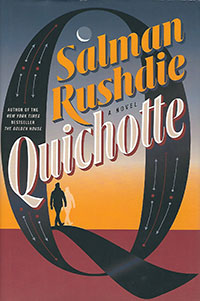 “Quichotte” (400 pages; $28) by Salman Rushdie; published by Random House
“Quichotte” (400 pages; $28) by Salman Rushdie; published by Random House
(www.randomhousebooks.com)
Patience, a heck of a lot of it. That’s what you need when you are reading a Salman Rushdie novel. With his latest “Quichotte,” you will need even more. Homage to Cervantes’ classic “Don Quixote,” this comes with a subplot, a plot within a plot, so to speak. So we have a Bombay native Quichotte, a single, genteel but confused salesman who is deeply in love with a Miss Salma R, an Indian actress-turned-Oprah-esque talk show host. Along with his teenaged imaginary son Sancho, he sets off in a Chevy Cruze on a picturesque journey across America to prove worthy of her hand. Quichotte is the creation of spy fiction writer and another Indian Sam DuChamp, who is looking to reunite with his own estranged sister. It appears Rushdie with all his finesse at magical realism, hyper-meta storytelling and absolute absurdity, is willing to take on just about any topic or make one up: opioid epidemic, racism as in white supremacy, life, death, technology, religion, reality TV, sci-fiction, satire, talking crickets and believe it or not mastodons. “There once lived at a series of temporary addresses across the United States of America, a traveling man of Indian origin, advancing years, and retreating mental powers, who, on account of his love for mindless television, had spent far too much of his life in the yellow light of tawdry motel rooms watching an excess of it, and had suffered a peculiar form of brain damage as a result,” so begins the novel. And it is till the very last page that the master storyteller Rushdie keeps a grip on the reader. “Time, that lethal chamber of horrors whose walls close slowly in upon the luckless inhabitant until they crush the life out of him …” Now that is sheer brilliance.
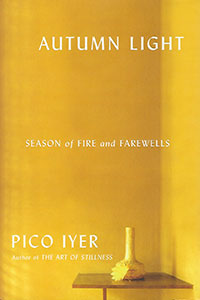 “Autumn Light: Season of Fire and Farewells” (248 pages; $25.95) by Pico Iyer; published by Alfred A. Knopf (www.aaknopf.com)
“Autumn Light: Season of Fire and Farewells” (248 pages; $25.95) by Pico Iyer; published by Alfred A. Knopf (www.aaknopf.com)
At the onset, we will confess Pico Iyer is our favorite travel author. His books about crossing cultures such as “Video Night in Kathmandu,” “The Lady and the Monk” and especially “The Global Soul” are treasures to be cherished forever. So is his latest venture, which begins with the author’s return to Nara, Japan after the sudden death of his father-in-law. Once the first permanent Buddhist capital of Japan, we read, as the author navigates the sleepy, old city of Nara, strolling the neighborhoods, Deer’s Slope and Slope of Light, Starbucks of course, a deer park, its post office and a bakery. Married to Hiroko, who has two children from a previous marriage, Iyer comes back to the country where he has had a home for 30 years in this part chronicle and part travel piece. “We cherish things, Japan has always known, precisely because they cannot last; it’s their frailty that adds sweetness to their beauty,” he muses while playing table tennis matches with the elderly (assigning intriguing names such as “Bodhisattva,:” “Charlie Brown,” “Wyrd Sisters” for easy identification) at a local club or experiencing “the reddening of the maple leaves under a blaze of ceramic-blue skies that is the place’s secret heart.” Going back and forth between yearly visits to Japan is a meeting with the Dalai Lama, who comforts Hiroko about the loss of her father. “Remember: Only body gone. Spirit still there. Only cover gone,” he tells her. Ever the philosopher himself, Iyer notes, “… I’d thought that autumn was the season that taught us how to die, only now do I see that in truth perhaps it’s dispensing the much harder challenge of learning how to watch everyone you care for die. Death can be hardest on the living.” This latest book is a poignant work of art that will leave you yearning for more from the author. As Iyer rightly says, “Autumn is the season when everything falls away.”
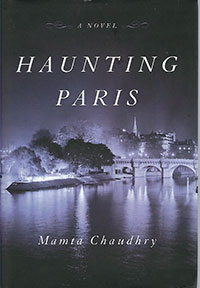 “Haunting Paris” (278 pages, $25.95) by Mamta Chaudhry; published by Nan A. Talese/Doubleday (www.nanatalese.com)
“Haunting Paris” (278 pages, $25.95) by Mamta Chaudhry; published by Nan A. Talese/Doubleday (www.nanatalese.com)
“Squandered time! The most enduring of regrets. In the end, a lifetime is not enough, the heart yearns for more. Who can reason with desire? The heart has its reasons that reason cannot know.” So notes lover Julien, a revenant, in this debut novel by Coral Gables resident Mamta Chaudhry, while watching his beloved Sylvie from beyond the grave. Set in 1989 Paris, the book takes us back to the horrors of World War II as Sylvie attempts to solve the mystery behind the disappearance of Julien’s sister and one of her daughters at Auschwitz. The transition between the two lovers, who were together for 30 years, is told extraordinarily well with the chapters for the deceased set aside in italics. “Why does one fall in love with one person and not another?” wonders Julien. “You might as well ask why this piece of music strikes a chord and not that one. Desire is a mystery the dead fathom no more than the living.” As the two lovers grieve, the yearning for unison again is pervasive. “After the span allowed to her by capricious Time, one day Sylvie will push open that curtained door to come to me, and despite all that I have known, at the sight of her I will finally believe all losses are restored and sorrows end.” For a debut author, Chaudhry has written a touching and powerful book, one that brings family secrets, longing, love, reprehensible crimes and sorrow to the forefront. “Haunting Paris” promises to ‘haunt’ you for a long time!
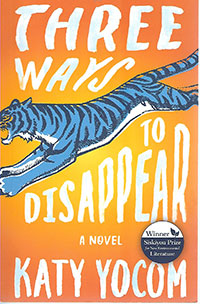 “Three Ways to Disappear” (310 pages; $18.95) by Katy Yocom; published by Ashland Creek Press (www.ashlandcreekpress.com)
“Three Ways to Disappear” (310 pages; $18.95) by Katy Yocom; published by Ashland Creek Press (www.ashlandcreekpress.com)
The year is 2000 and ex-journalist Sarah DeVaughan has returned to the habitat of Ranthambore National Park to help preserve the endangered Bengal tiger. India is also the place where Sarah, her elder sister Quinn (“Go save those tigers,” she had told Sarah) and the DeVaughan family had endured unspeakable disaster in their childhood. It was here that at the age of 7, Sarah’s twin brother Marcus died of cholera. But Quinn who is married (albeit, not happily) with twins stays back home in Louisville, Ky. “India was a hard place to live, a hard place to make anything change. A hard place to get past the tragic and the absurd,” recognizes Sarah while touring the tiger park. It isn’t long before the 32-year-old gets tangled in local politics and simultaneously falls in love with an Indian co-worker. Quinn, who isn’t too keen to visit the place of their childhood trauma, is convinced by her sister to make another trip. “Lately (Quinn) she has begun to think of the past as a vast place, dark and mysterious as a forest. Always decaying, collapsing in upon itself, only to bring forth new growth in the most surprising of places,” marks Yocom. The narrative, told in alternating views by the two sisters, but simultaneously highlighting the plight of the villagers and conservationists, has a fascinating plot that ends on a sad note. For a first-time novelist, Yocom has written a fine tale that embraces the majestic Bengal tiger on one side; and childhood trauma, marriage, family secrets, tragedy, forbidden love and compassion on the other.
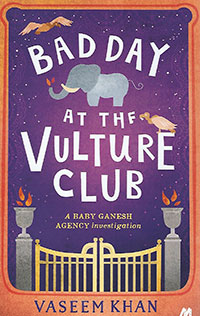 “Bad Day at the Vulture Club” (380 pages; $26.99) by Vaseem Khan; published by Mulholland Books (www.hodder.co.uk)
“Bad Day at the Vulture Club” (380 pages; $26.99) by Vaseem Khan; published by Mulholland Books (www.hodder.co.uk)
After “The Unexpected Inheritance of Inspector Chopra,” “The Perplexing Theft of the Jewel in the Crown” and “The Strange Disappearance of a Bollywood Star” comes another tale from Vaseem Khan. In the latest Baby Ganesh Detective Agency mystery series book, retired Inspector Ashwin Chopra solves the death of a wealthy and respected Parsee gentleman who is murdered on holy ground and his body dumped inside a Towers of Silence, where the Parsee dead are consumed by vultures. As always, he is aided by Baby Ganesh and ex-police colleague Rangwalla, who gets an intriguing sub-plot of his own. Then there is Irfan, former street urchin but now a bona fide Chopra family member. Not as visible as in previous books is Chopra’s charming wife Poppy, who has joined the Take the Poo to the Loo campaign to embrace the challenge of ending open defecation. She has put up a poster in the building complex depicting “a series of cartoons of an average-looking Indian man walking along the street, before stepping, with exaggerated disgust, into a pile of excrement.” This causes quite a ruckus, somewhat hilarious, with the president of the complex’s managing committee. Truly, Bombay, now Mumbai, comes back to life as in: “A shabby, twelve-storey tower in a rundown part of the mid-town Dadar district, the building, with its flaking grey walls, caged balconies, cheap advertising hoardings and thickets of snaking electrical and phone cables, looked severely ill, as if it had contracted some sort of debilitating architectural disease.” Our kudos go to Khan for yet another fascinating crime mystery. We eagerly await the next in the Baby Ganesh Detective Agency series.
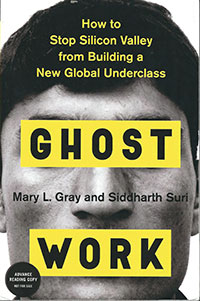 “Ghost Work: How to stop Silicon Valley from Building a New Global Underclass” (288 pages; $27) by Mary L. Gray and Siddharth Suri; published by Houghton Mifflin Harcourt (www.hmhco.com)
“Ghost Work: How to stop Silicon Valley from Building a New Global Underclass” (288 pages; $27) by Mary L. Gray and Siddharth Suri; published by Houghton Mifflin Harcourt (www.hmhco.com)
So you are surfing on Google. Or buying merchandise on Amazon. Maybe booking your hotel at expedia.com Good for you. But ever wonder: How does the gig world function so efficiently and smartly? That’s where the “ghost work” done by people behind the scenes comes into focus. It could be stressed young mothers, professionals forced into early retirement, recent grads that can’t get a footing on the traditional employment ladder, or minorities unable to find jobs. In other words, about 8 percent of Americans have worked at least once in this “ghost economy” and that number is growing, say Gray and Suri. The authors focused on nearly 200 in-person interviews with workers and 50 in-person chats with those hiring on-demand workers living in India and the United States, and examined four different ghost work platforms: Amazon.com’s Mechanical Tuk (MTurk); Microsoft’s internal Universal Human Relevance System (UHRS); socially minded LeadGenius; and the nonprofit Amara.org Unlike assembly workers of the past and some today, there are no health benefits or legal minimum pay set, and worse of all, these overworked and underpaid workforces can be fired for any reason or none whatsoever. Some in the gig economy have even reported not getting paid for the work or fighting a battle to collect wages. Lost amid the on-demand economy is that the workers have a tight social network, a connection, bond with their colleagues. The shadow of Artificial Intelligence looms but it is still not within reach of upsetting the applecart. Gray and Suri rightly call for a different set of benefits and safety nets for the new workforce, which isn’t your traditional 9-to-5 full-time job.
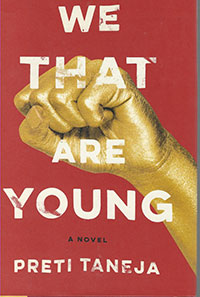 “We That are Young” (490 pages, $27.95) by Preti Taneja; published by Alfred A. Knopf (www.aaknopf.com)
“We That are Young” (490 pages, $27.95) by Preti Taneja; published by Alfred A. Knopf (www.aaknopf.com)
If you are familiar with Shakespeare’s “King Lear,” then you will find the story similar, though set in modern India. Jivan Singh, bastard son of Devraj Bapuji, returns to his childhood home after 15 years in the United States – only to discover that the ageing patriarch of the Devraj Company he founded has unexpectedly resigned. Then there is Sita, Devraj’s youngest daughter, who flees – refusing to submit to the marriage her father wants for her. Meanwhile, Radha and Gargi, Sita’s older sisters, must deal with the consequences. Thus begins a fierce, deadly struggle for power, which spans from the luxury hotels and spas of New Delhi and Amritsar, the palaces, and slums of the fabled Napurthala, to Srinagar. The story, divided into five chapters (characters, rather), is related in meticulously written prose as the ever-expanding gap between the filthy rich and the extremely poor is laid bare before the reader. Be cautioned that like Salman Rushdie or Arundhati Roy novels, this one too requires attention and concentration, what with a complexly told storyline going back and forth and intertwined characters that will stoop to corruption, deceit and murder. Here are some catchy lines: “Confusion: the bastard half brother of chaos. Chaos: the torture instrument of forgetting.” “Sacrifice creates the heat that keeps the world turning. If no one sacrifices, the sun will not rise.” “Sin comes in many forms … It can be an act. Or a lack of action. It can be a lie or believing a liar. Doubt is one of the worst sins of all.” Be patient, take your time with the book and you will enjoy the nearly 500-page read. For a debut novel, Taneja shines even though the subjects (characters) are somewhat hollow and depressing.